An Analysis of Gastronomy's Influence on Tourism in Melbourne
VerifiedAdded on 2022/10/18
|13
|3358
|32
Report
AI Summary
This report examines the crucial role of gastronomy in facilitating tourism, highlighting its increasing importance as a global phenomenon. It explores how local cuisine and food experiences have become integral to cultural heritage and destination marketing, leading to the rise of concepts like culinary tourism and agritourism. The report analyzes the factors influencing tourist experiences, including culture, perception, and service, and provides case studies of Melbourne, Australia, focusing on Queen Victoria Market and food trucks to illustrate gastronomy's impact. The report discusses gastronomy's link to the experience economy, cultural heritage, and destination marketing, emphasizing its influence on tourist behavior and the strategies used to attract visitors through food-related experiences.

Student’s last Name 1
Principles of Gastronomy
By (Name)
Course
Professor
University
Date
Principles of Gastronomy
By (Name)
Course
Professor
University
Date
Paraphrase This Document
Need a fresh take? Get an instant paraphrase of this document with our AI Paraphraser
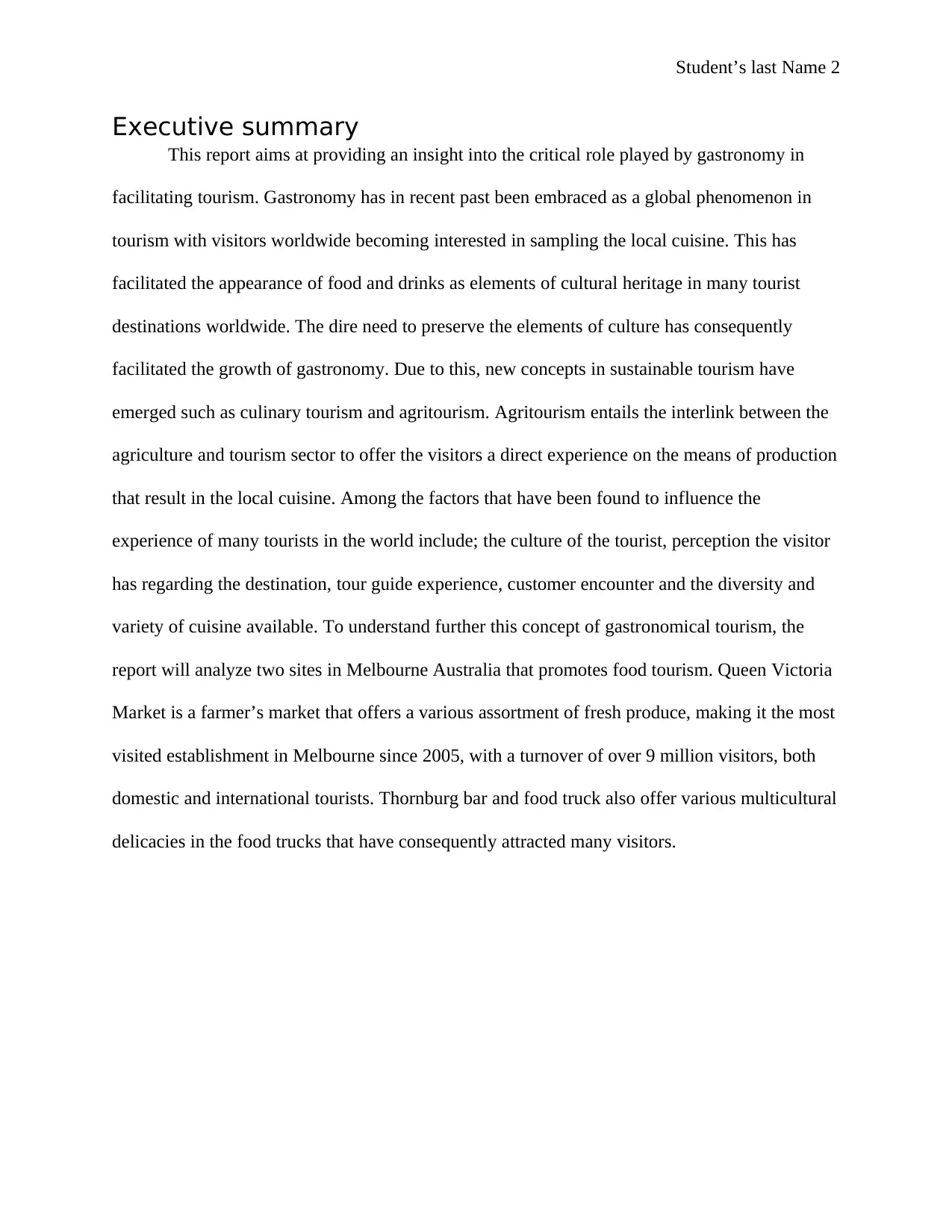
Student’s last Name 2
Executive summary
This report aims at providing an insight into the critical role played by gastronomy in
facilitating tourism. Gastronomy has in recent past been embraced as a global phenomenon in
tourism with visitors worldwide becoming interested in sampling the local cuisine. This has
facilitated the appearance of food and drinks as elements of cultural heritage in many tourist
destinations worldwide. The dire need to preserve the elements of culture has consequently
facilitated the growth of gastronomy. Due to this, new concepts in sustainable tourism have
emerged such as culinary tourism and agritourism. Agritourism entails the interlink between the
agriculture and tourism sector to offer the visitors a direct experience on the means of production
that result in the local cuisine. Among the factors that have been found to influence the
experience of many tourists in the world include; the culture of the tourist, perception the visitor
has regarding the destination, tour guide experience, customer encounter and the diversity and
variety of cuisine available. To understand further this concept of gastronomical tourism, the
report will analyze two sites in Melbourne Australia that promotes food tourism. Queen Victoria
Market is a farmer’s market that offers a various assortment of fresh produce, making it the most
visited establishment in Melbourne since 2005, with a turnover of over 9 million visitors, both
domestic and international tourists. Thornburg bar and food truck also offer various multicultural
delicacies in the food trucks that have consequently attracted many visitors.
Executive summary
This report aims at providing an insight into the critical role played by gastronomy in
facilitating tourism. Gastronomy has in recent past been embraced as a global phenomenon in
tourism with visitors worldwide becoming interested in sampling the local cuisine. This has
facilitated the appearance of food and drinks as elements of cultural heritage in many tourist
destinations worldwide. The dire need to preserve the elements of culture has consequently
facilitated the growth of gastronomy. Due to this, new concepts in sustainable tourism have
emerged such as culinary tourism and agritourism. Agritourism entails the interlink between the
agriculture and tourism sector to offer the visitors a direct experience on the means of production
that result in the local cuisine. Among the factors that have been found to influence the
experience of many tourists in the world include; the culture of the tourist, perception the visitor
has regarding the destination, tour guide experience, customer encounter and the diversity and
variety of cuisine available. To understand further this concept of gastronomical tourism, the
report will analyze two sites in Melbourne Australia that promotes food tourism. Queen Victoria
Market is a farmer’s market that offers a various assortment of fresh produce, making it the most
visited establishment in Melbourne since 2005, with a turnover of over 9 million visitors, both
domestic and international tourists. Thornburg bar and food truck also offer various multicultural
delicacies in the food trucks that have consequently attracted many visitors.
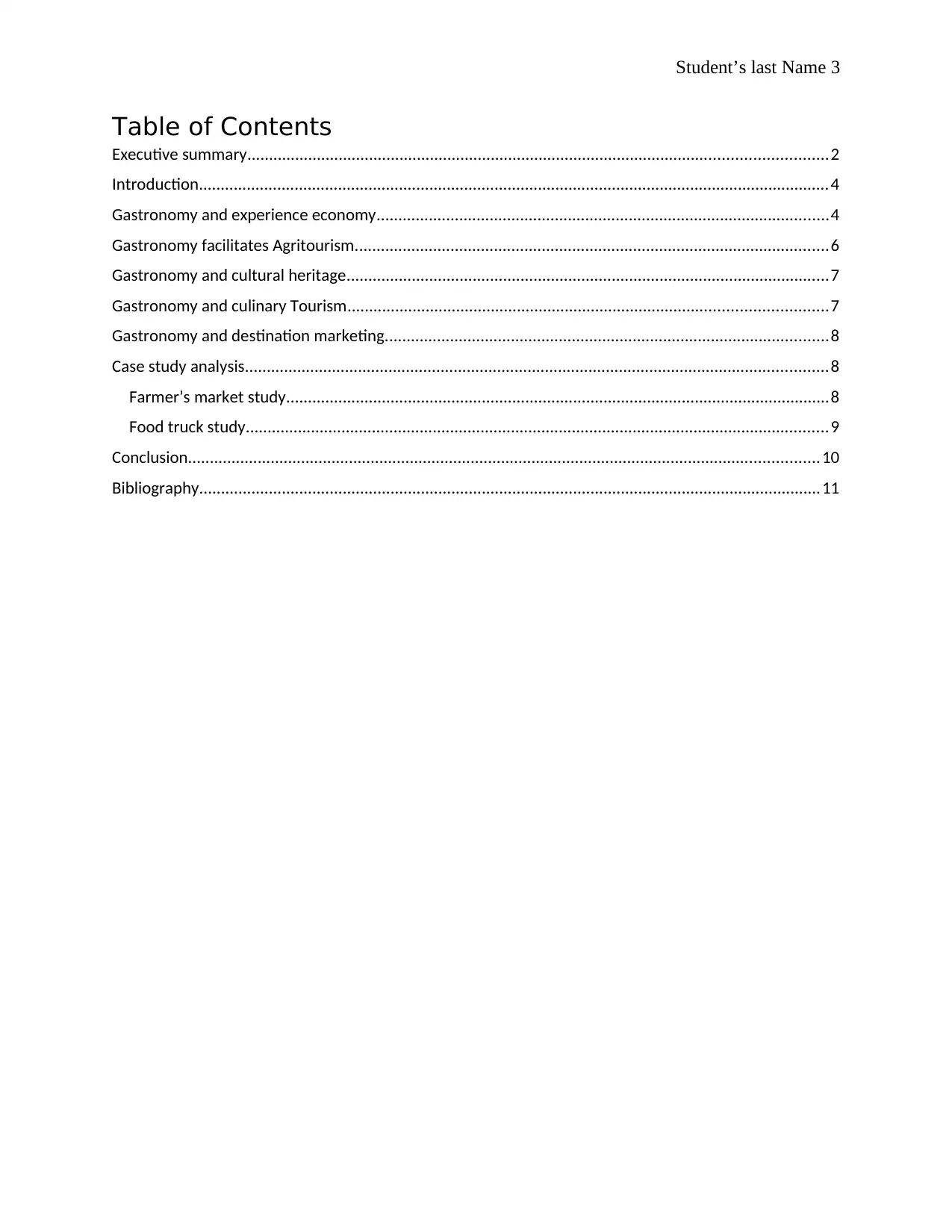
Student’s last Name 3
Table of Contents
Executive summary.....................................................................................................................................2
Introduction.................................................................................................................................................4
Gastronomy and experience economy........................................................................................................4
Gastronomy facilitates Agritourism.............................................................................................................6
Gastronomy and cultural heritage...............................................................................................................7
Gastronomy and culinary Tourism..............................................................................................................7
Gastronomy and destination marketing......................................................................................................8
Case study analysis......................................................................................................................................8
Farmer’s market study.............................................................................................................................8
Food truck study......................................................................................................................................9
Conclusion.................................................................................................................................................10
Bibliography...............................................................................................................................................11
Table of Contents
Executive summary.....................................................................................................................................2
Introduction.................................................................................................................................................4
Gastronomy and experience economy........................................................................................................4
Gastronomy facilitates Agritourism.............................................................................................................6
Gastronomy and cultural heritage...............................................................................................................7
Gastronomy and culinary Tourism..............................................................................................................7
Gastronomy and destination marketing......................................................................................................8
Case study analysis......................................................................................................................................8
Farmer’s market study.............................................................................................................................8
Food truck study......................................................................................................................................9
Conclusion.................................................................................................................................................10
Bibliography...............................................................................................................................................11
⊘ This is a preview!⊘
Do you want full access?
Subscribe today to unlock all pages.

Trusted by 1+ million students worldwide
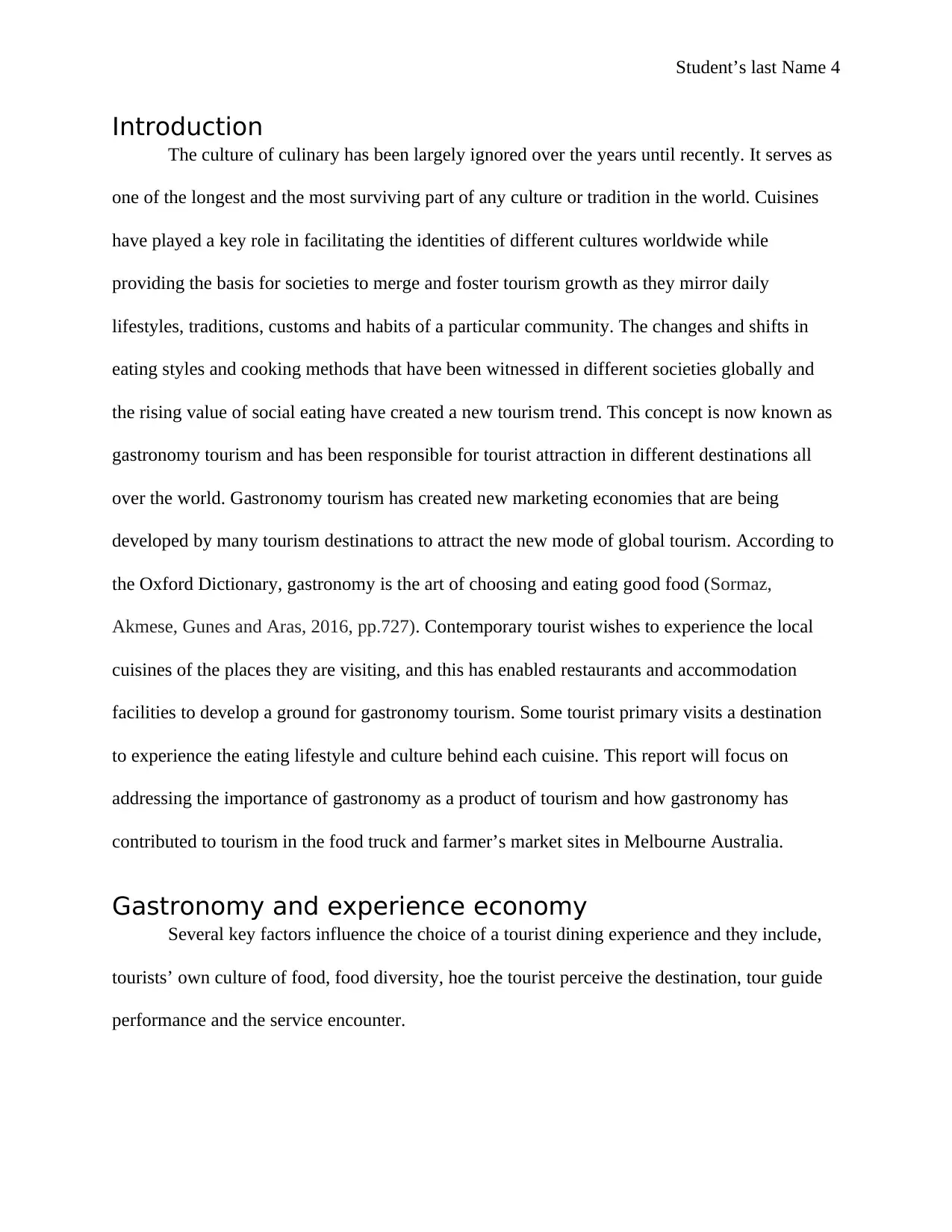
Student’s last Name 4
Introduction
The culture of culinary has been largely ignored over the years until recently. It serves as
one of the longest and the most surviving part of any culture or tradition in the world. Cuisines
have played a key role in facilitating the identities of different cultures worldwide while
providing the basis for societies to merge and foster tourism growth as they mirror daily
lifestyles, traditions, customs and habits of a particular community. The changes and shifts in
eating styles and cooking methods that have been witnessed in different societies globally and
the rising value of social eating have created a new tourism trend. This concept is now known as
gastronomy tourism and has been responsible for tourist attraction in different destinations all
over the world. Gastronomy tourism has created new marketing economies that are being
developed by many tourism destinations to attract the new mode of global tourism. According to
the Oxford Dictionary, gastronomy is the art of choosing and eating good food (Sormaz,
Akmese, Gunes and Aras, 2016, pp.727). Contemporary tourist wishes to experience the local
cuisines of the places they are visiting, and this has enabled restaurants and accommodation
facilities to develop a ground for gastronomy tourism. Some tourist primary visits a destination
to experience the eating lifestyle and culture behind each cuisine. This report will focus on
addressing the importance of gastronomy as a product of tourism and how gastronomy has
contributed to tourism in the food truck and farmer’s market sites in Melbourne Australia.
Gastronomy and experience economy
Several key factors influence the choice of a tourist dining experience and they include,
tourists’ own culture of food, food diversity, hoe the tourist perceive the destination, tour guide
performance and the service encounter.
Introduction
The culture of culinary has been largely ignored over the years until recently. It serves as
one of the longest and the most surviving part of any culture or tradition in the world. Cuisines
have played a key role in facilitating the identities of different cultures worldwide while
providing the basis for societies to merge and foster tourism growth as they mirror daily
lifestyles, traditions, customs and habits of a particular community. The changes and shifts in
eating styles and cooking methods that have been witnessed in different societies globally and
the rising value of social eating have created a new tourism trend. This concept is now known as
gastronomy tourism and has been responsible for tourist attraction in different destinations all
over the world. Gastronomy tourism has created new marketing economies that are being
developed by many tourism destinations to attract the new mode of global tourism. According to
the Oxford Dictionary, gastronomy is the art of choosing and eating good food (Sormaz,
Akmese, Gunes and Aras, 2016, pp.727). Contemporary tourist wishes to experience the local
cuisines of the places they are visiting, and this has enabled restaurants and accommodation
facilities to develop a ground for gastronomy tourism. Some tourist primary visits a destination
to experience the eating lifestyle and culture behind each cuisine. This report will focus on
addressing the importance of gastronomy as a product of tourism and how gastronomy has
contributed to tourism in the food truck and farmer’s market sites in Melbourne Australia.
Gastronomy and experience economy
Several key factors influence the choice of a tourist dining experience and they include,
tourists’ own culture of food, food diversity, hoe the tourist perceive the destination, tour guide
performance and the service encounter.
Paraphrase This Document
Need a fresh take? Get an instant paraphrase of this document with our AI Paraphraser
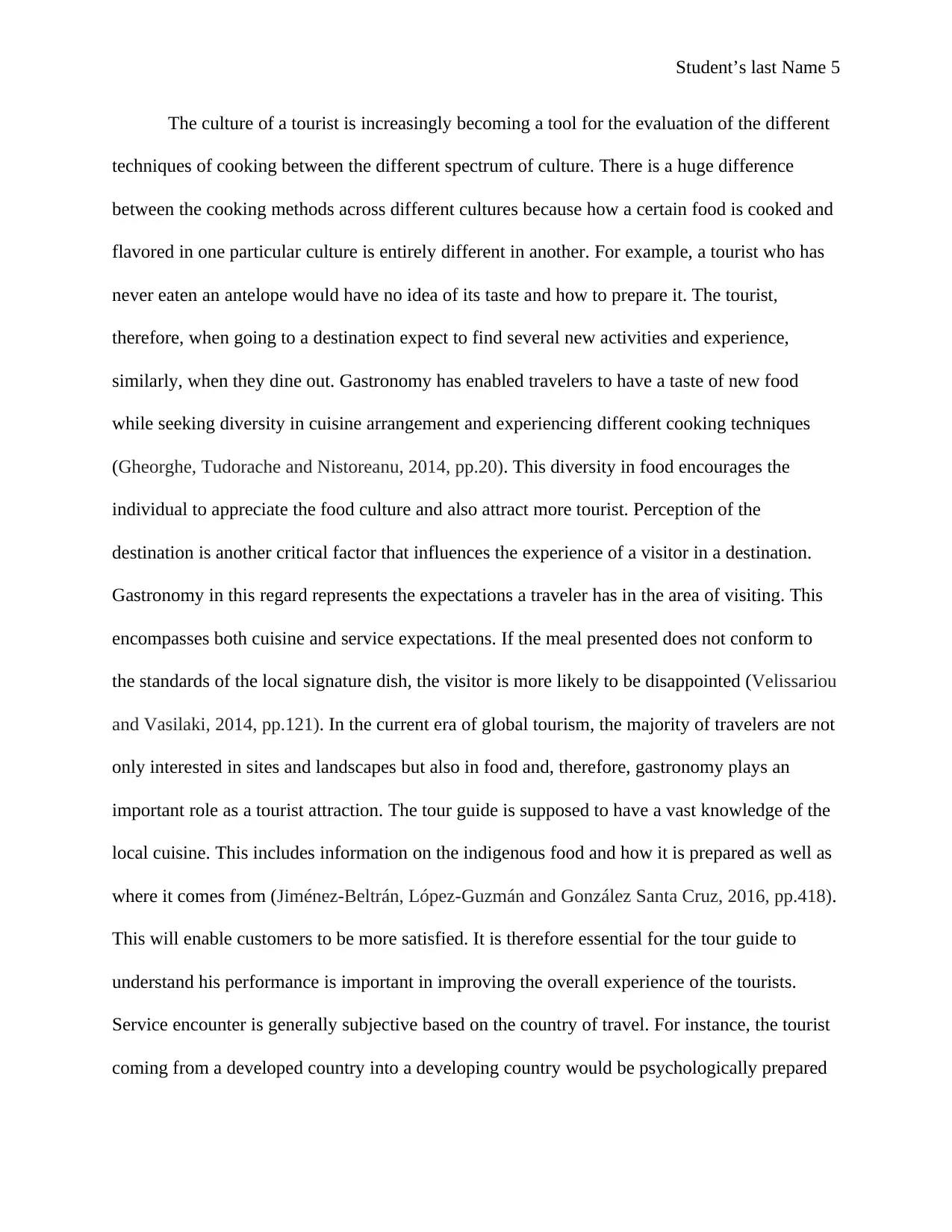
Student’s last Name 5
The culture of a tourist is increasingly becoming a tool for the evaluation of the different
techniques of cooking between the different spectrum of culture. There is a huge difference
between the cooking methods across different cultures because how a certain food is cooked and
flavored in one particular culture is entirely different in another. For example, a tourist who has
never eaten an antelope would have no idea of its taste and how to prepare it. The tourist,
therefore, when going to a destination expect to find several new activities and experience,
similarly, when they dine out. Gastronomy has enabled travelers to have a taste of new food
while seeking diversity in cuisine arrangement and experiencing different cooking techniques
(Gheorghe, Tudorache and Nistoreanu, 2014, pp.20). This diversity in food encourages the
individual to appreciate the food culture and also attract more tourist. Perception of the
destination is another critical factor that influences the experience of a visitor in a destination.
Gastronomy in this regard represents the expectations a traveler has in the area of visiting. This
encompasses both cuisine and service expectations. If the meal presented does not conform to
the standards of the local signature dish, the visitor is more likely to be disappointed (Velissariou
and Vasilaki, 2014, pp.121). In the current era of global tourism, the majority of travelers are not
only interested in sites and landscapes but also in food and, therefore, gastronomy plays an
important role as a tourist attraction. The tour guide is supposed to have a vast knowledge of the
local cuisine. This includes information on the indigenous food and how it is prepared as well as
where it comes from (Jiménez-Beltrán, López-Guzmán and González Santa Cruz, 2016, pp.418).
This will enable customers to be more satisfied. It is therefore essential for the tour guide to
understand his performance is important in improving the overall experience of the tourists.
Service encounter is generally subjective based on the country of travel. For instance, the tourist
coming from a developed country into a developing country would be psychologically prepared
The culture of a tourist is increasingly becoming a tool for the evaluation of the different
techniques of cooking between the different spectrum of culture. There is a huge difference
between the cooking methods across different cultures because how a certain food is cooked and
flavored in one particular culture is entirely different in another. For example, a tourist who has
never eaten an antelope would have no idea of its taste and how to prepare it. The tourist,
therefore, when going to a destination expect to find several new activities and experience,
similarly, when they dine out. Gastronomy has enabled travelers to have a taste of new food
while seeking diversity in cuisine arrangement and experiencing different cooking techniques
(Gheorghe, Tudorache and Nistoreanu, 2014, pp.20). This diversity in food encourages the
individual to appreciate the food culture and also attract more tourist. Perception of the
destination is another critical factor that influences the experience of a visitor in a destination.
Gastronomy in this regard represents the expectations a traveler has in the area of visiting. This
encompasses both cuisine and service expectations. If the meal presented does not conform to
the standards of the local signature dish, the visitor is more likely to be disappointed (Velissariou
and Vasilaki, 2014, pp.121). In the current era of global tourism, the majority of travelers are not
only interested in sites and landscapes but also in food and, therefore, gastronomy plays an
important role as a tourist attraction. The tour guide is supposed to have a vast knowledge of the
local cuisine. This includes information on the indigenous food and how it is prepared as well as
where it comes from (Jiménez-Beltrán, López-Guzmán and González Santa Cruz, 2016, pp.418).
This will enable customers to be more satisfied. It is therefore essential for the tour guide to
understand his performance is important in improving the overall experience of the tourists.
Service encounter is generally subjective based on the country of travel. For instance, the tourist
coming from a developed country into a developing country would be psychologically prepared
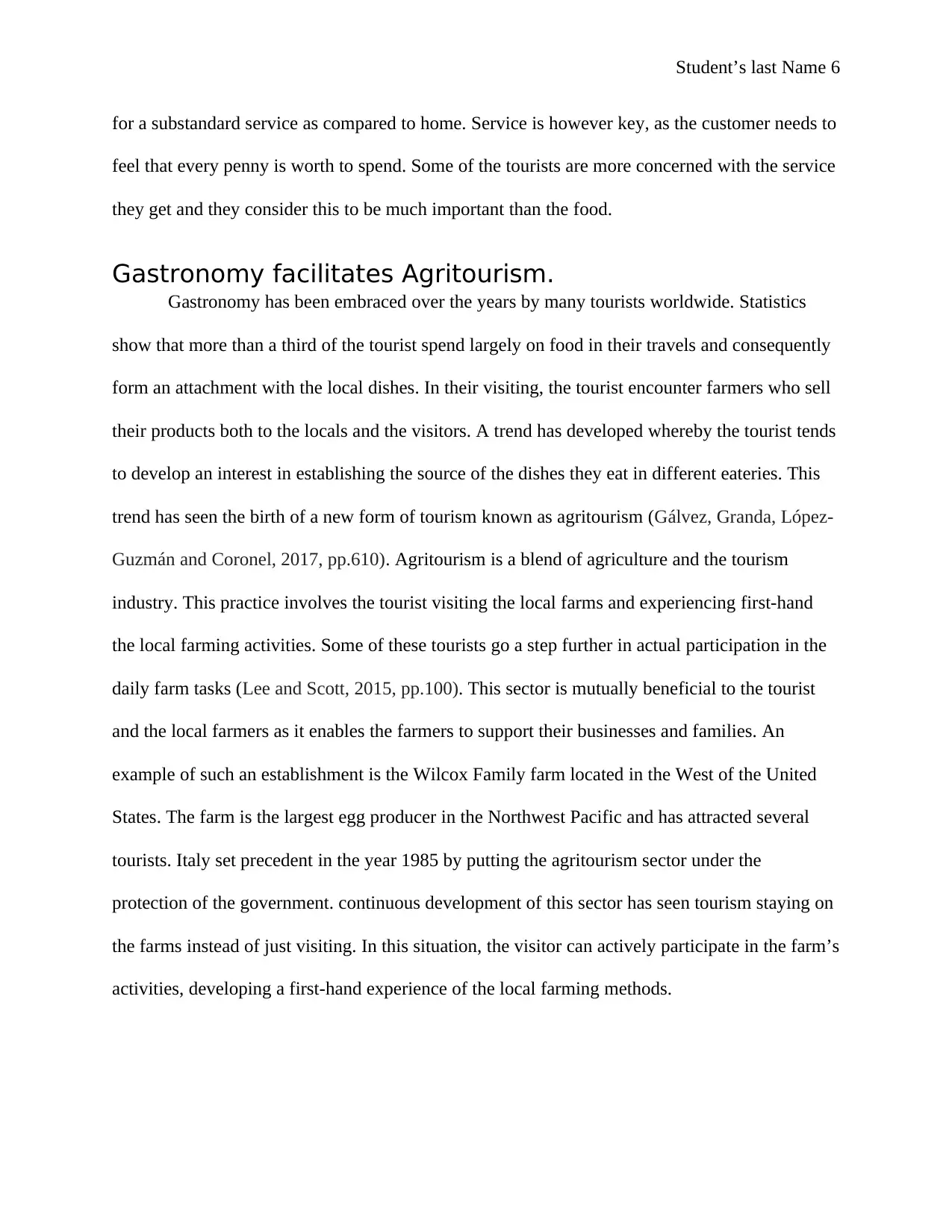
Student’s last Name 6
for a substandard service as compared to home. Service is however key, as the customer needs to
feel that every penny is worth to spend. Some of the tourists are more concerned with the service
they get and they consider this to be much important than the food.
Gastronomy facilitates Agritourism.
Gastronomy has been embraced over the years by many tourists worldwide. Statistics
show that more than a third of the tourist spend largely on food in their travels and consequently
form an attachment with the local dishes. In their visiting, the tourist encounter farmers who sell
their products both to the locals and the visitors. A trend has developed whereby the tourist tends
to develop an interest in establishing the source of the dishes they eat in different eateries. This
trend has seen the birth of a new form of tourism known as agritourism (Gálvez, Granda, López-
Guzmán and Coronel, 2017, pp.610). Agritourism is a blend of agriculture and the tourism
industry. This practice involves the tourist visiting the local farms and experiencing first-hand
the local farming activities. Some of these tourists go a step further in actual participation in the
daily farm tasks (Lee and Scott, 2015, pp.100). This sector is mutually beneficial to the tourist
and the local farmers as it enables the farmers to support their businesses and families. An
example of such an establishment is the Wilcox Family farm located in the West of the United
States. The farm is the largest egg producer in the Northwest Pacific and has attracted several
tourists. Italy set precedent in the year 1985 by putting the agritourism sector under the
protection of the government. continuous development of this sector has seen tourism staying on
the farms instead of just visiting. In this situation, the visitor can actively participate in the farm’s
activities, developing a first-hand experience of the local farming methods.
for a substandard service as compared to home. Service is however key, as the customer needs to
feel that every penny is worth to spend. Some of the tourists are more concerned with the service
they get and they consider this to be much important than the food.
Gastronomy facilitates Agritourism.
Gastronomy has been embraced over the years by many tourists worldwide. Statistics
show that more than a third of the tourist spend largely on food in their travels and consequently
form an attachment with the local dishes. In their visiting, the tourist encounter farmers who sell
their products both to the locals and the visitors. A trend has developed whereby the tourist tends
to develop an interest in establishing the source of the dishes they eat in different eateries. This
trend has seen the birth of a new form of tourism known as agritourism (Gálvez, Granda, López-
Guzmán and Coronel, 2017, pp.610). Agritourism is a blend of agriculture and the tourism
industry. This practice involves the tourist visiting the local farms and experiencing first-hand
the local farming activities. Some of these tourists go a step further in actual participation in the
daily farm tasks (Lee and Scott, 2015, pp.100). This sector is mutually beneficial to the tourist
and the local farmers as it enables the farmers to support their businesses and families. An
example of such an establishment is the Wilcox Family farm located in the West of the United
States. The farm is the largest egg producer in the Northwest Pacific and has attracted several
tourists. Italy set precedent in the year 1985 by putting the agritourism sector under the
protection of the government. continuous development of this sector has seen tourism staying on
the farms instead of just visiting. In this situation, the visitor can actively participate in the farm’s
activities, developing a first-hand experience of the local farming methods.
⊘ This is a preview!⊘
Do you want full access?
Subscribe today to unlock all pages.

Trusted by 1+ million students worldwide
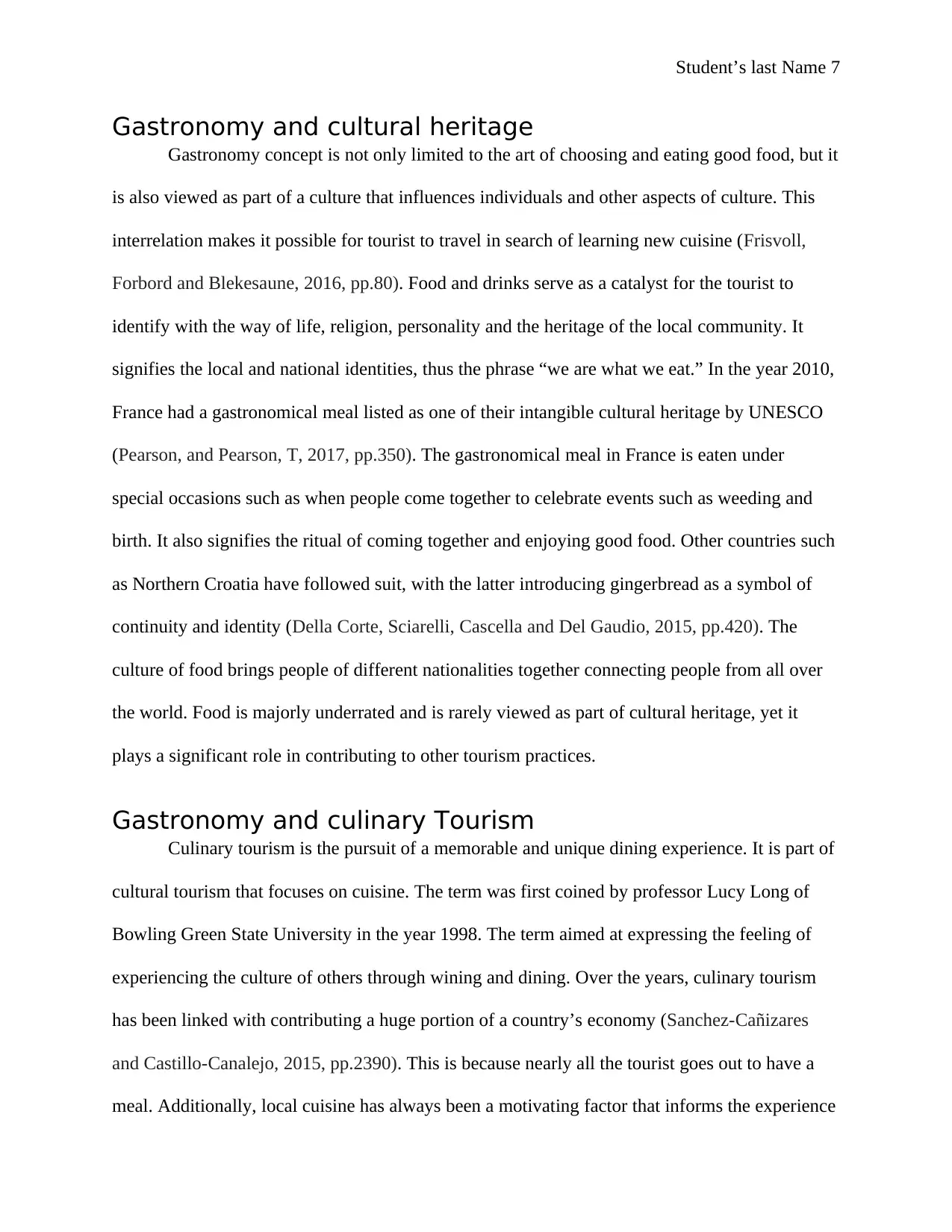
Student’s last Name 7
Gastronomy and cultural heritage
Gastronomy concept is not only limited to the art of choosing and eating good food, but it
is also viewed as part of a culture that influences individuals and other aspects of culture. This
interrelation makes it possible for tourist to travel in search of learning new cuisine (Frisvoll,
Forbord and Blekesaune, 2016, pp.80). Food and drinks serve as a catalyst for the tourist to
identify with the way of life, religion, personality and the heritage of the local community. It
signifies the local and national identities, thus the phrase “we are what we eat.” In the year 2010,
France had a gastronomical meal listed as one of their intangible cultural heritage by UNESCO
(Pearson, and Pearson, T, 2017, pp.350). The gastronomical meal in France is eaten under
special occasions such as when people come together to celebrate events such as weeding and
birth. It also signifies the ritual of coming together and enjoying good food. Other countries such
as Northern Croatia have followed suit, with the latter introducing gingerbread as a symbol of
continuity and identity (Della Corte, Sciarelli, Cascella and Del Gaudio, 2015, pp.420). The
culture of food brings people of different nationalities together connecting people from all over
the world. Food is majorly underrated and is rarely viewed as part of cultural heritage, yet it
plays a significant role in contributing to other tourism practices.
Gastronomy and culinary Tourism
Culinary tourism is the pursuit of a memorable and unique dining experience. It is part of
cultural tourism that focuses on cuisine. The term was first coined by professor Lucy Long of
Bowling Green State University in the year 1998. The term aimed at expressing the feeling of
experiencing the culture of others through wining and dining. Over the years, culinary tourism
has been linked with contributing a huge portion of a country’s economy (Sanchez-Cañizares
and Castillo-Canalejo, 2015, pp.2390). This is because nearly all the tourist goes out to have a
meal. Additionally, local cuisine has always been a motivating factor that informs the experience
Gastronomy and cultural heritage
Gastronomy concept is not only limited to the art of choosing and eating good food, but it
is also viewed as part of a culture that influences individuals and other aspects of culture. This
interrelation makes it possible for tourist to travel in search of learning new cuisine (Frisvoll,
Forbord and Blekesaune, 2016, pp.80). Food and drinks serve as a catalyst for the tourist to
identify with the way of life, religion, personality and the heritage of the local community. It
signifies the local and national identities, thus the phrase “we are what we eat.” In the year 2010,
France had a gastronomical meal listed as one of their intangible cultural heritage by UNESCO
(Pearson, and Pearson, T, 2017, pp.350). The gastronomical meal in France is eaten under
special occasions such as when people come together to celebrate events such as weeding and
birth. It also signifies the ritual of coming together and enjoying good food. Other countries such
as Northern Croatia have followed suit, with the latter introducing gingerbread as a symbol of
continuity and identity (Della Corte, Sciarelli, Cascella and Del Gaudio, 2015, pp.420). The
culture of food brings people of different nationalities together connecting people from all over
the world. Food is majorly underrated and is rarely viewed as part of cultural heritage, yet it
plays a significant role in contributing to other tourism practices.
Gastronomy and culinary Tourism
Culinary tourism is the pursuit of a memorable and unique dining experience. It is part of
cultural tourism that focuses on cuisine. The term was first coined by professor Lucy Long of
Bowling Green State University in the year 1998. The term aimed at expressing the feeling of
experiencing the culture of others through wining and dining. Over the years, culinary tourism
has been linked with contributing a huge portion of a country’s economy (Sanchez-Cañizares
and Castillo-Canalejo, 2015, pp.2390). This is because nearly all the tourist goes out to have a
meal. Additionally, local cuisine has always been a motivating factor that informs the experience
Paraphrase This Document
Need a fresh take? Get an instant paraphrase of this document with our AI Paraphraser
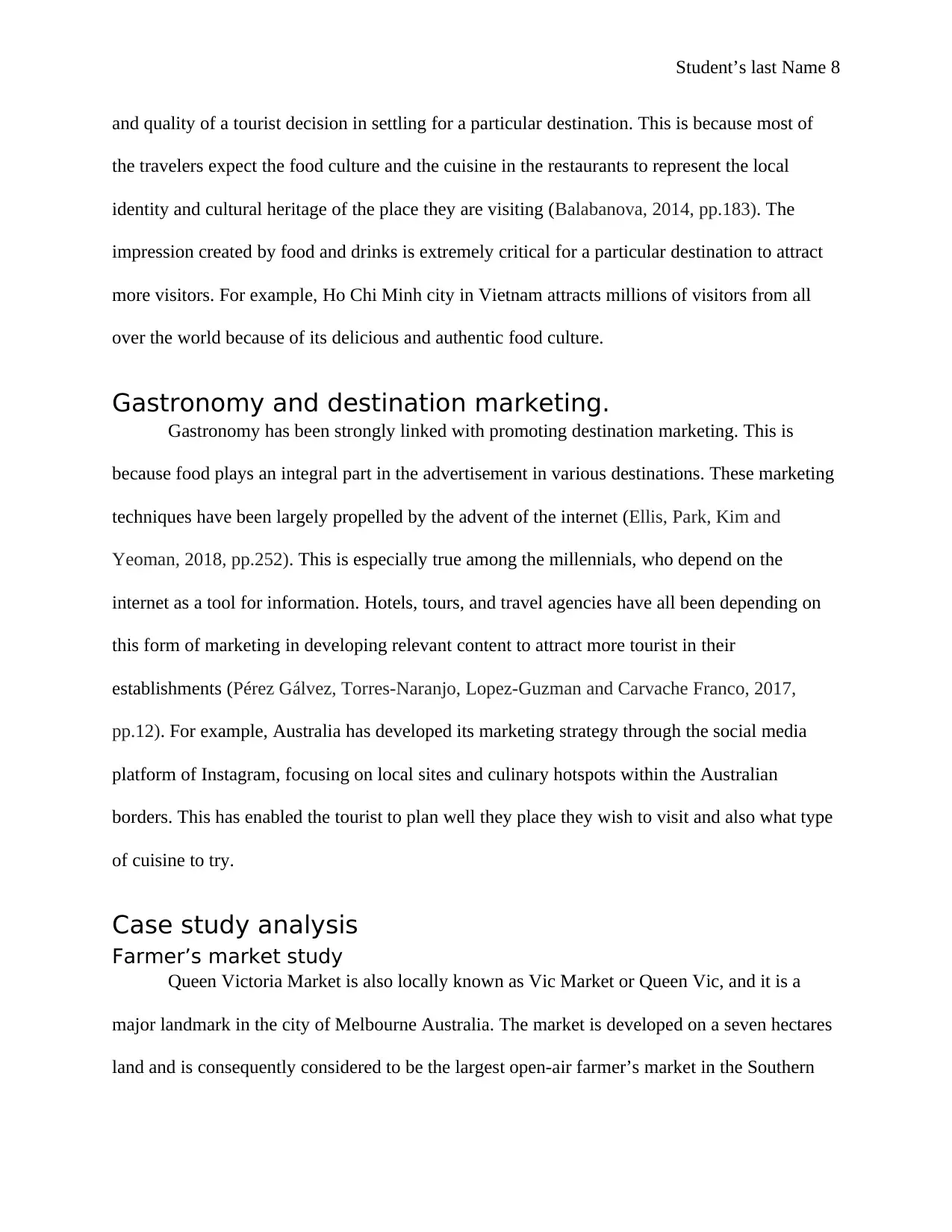
Student’s last Name 8
and quality of a tourist decision in settling for a particular destination. This is because most of
the travelers expect the food culture and the cuisine in the restaurants to represent the local
identity and cultural heritage of the place they are visiting (Balabanova, 2014, pp.183). The
impression created by food and drinks is extremely critical for a particular destination to attract
more visitors. For example, Ho Chi Minh city in Vietnam attracts millions of visitors from all
over the world because of its delicious and authentic food culture.
Gastronomy and destination marketing.
Gastronomy has been strongly linked with promoting destination marketing. This is
because food plays an integral part in the advertisement in various destinations. These marketing
techniques have been largely propelled by the advent of the internet (Ellis, Park, Kim and
Yeoman, 2018, pp.252). This is especially true among the millennials, who depend on the
internet as a tool for information. Hotels, tours, and travel agencies have all been depending on
this form of marketing in developing relevant content to attract more tourist in their
establishments (Pérez Gálvez, Torres-Naranjo, Lopez-Guzman and Carvache Franco, 2017,
pp.12). For example, Australia has developed its marketing strategy through the social media
platform of Instagram, focusing on local sites and culinary hotspots within the Australian
borders. This has enabled the tourist to plan well they place they wish to visit and also what type
of cuisine to try.
Case study analysis
Farmer’s market study
Queen Victoria Market is also locally known as Vic Market or Queen Vic, and it is a
major landmark in the city of Melbourne Australia. The market is developed on a seven hectares
land and is consequently considered to be the largest open-air farmer’s market in the Southern
and quality of a tourist decision in settling for a particular destination. This is because most of
the travelers expect the food culture and the cuisine in the restaurants to represent the local
identity and cultural heritage of the place they are visiting (Balabanova, 2014, pp.183). The
impression created by food and drinks is extremely critical for a particular destination to attract
more visitors. For example, Ho Chi Minh city in Vietnam attracts millions of visitors from all
over the world because of its delicious and authentic food culture.
Gastronomy and destination marketing.
Gastronomy has been strongly linked with promoting destination marketing. This is
because food plays an integral part in the advertisement in various destinations. These marketing
techniques have been largely propelled by the advent of the internet (Ellis, Park, Kim and
Yeoman, 2018, pp.252). This is especially true among the millennials, who depend on the
internet as a tool for information. Hotels, tours, and travel agencies have all been depending on
this form of marketing in developing relevant content to attract more tourist in their
establishments (Pérez Gálvez, Torres-Naranjo, Lopez-Guzman and Carvache Franco, 2017,
pp.12). For example, Australia has developed its marketing strategy through the social media
platform of Instagram, focusing on local sites and culinary hotspots within the Australian
borders. This has enabled the tourist to plan well they place they wish to visit and also what type
of cuisine to try.
Case study analysis
Farmer’s market study
Queen Victoria Market is also locally known as Vic Market or Queen Vic, and it is a
major landmark in the city of Melbourne Australia. The market is developed on a seven hectares
land and is consequently considered to be the largest open-air farmer’s market in the Southern
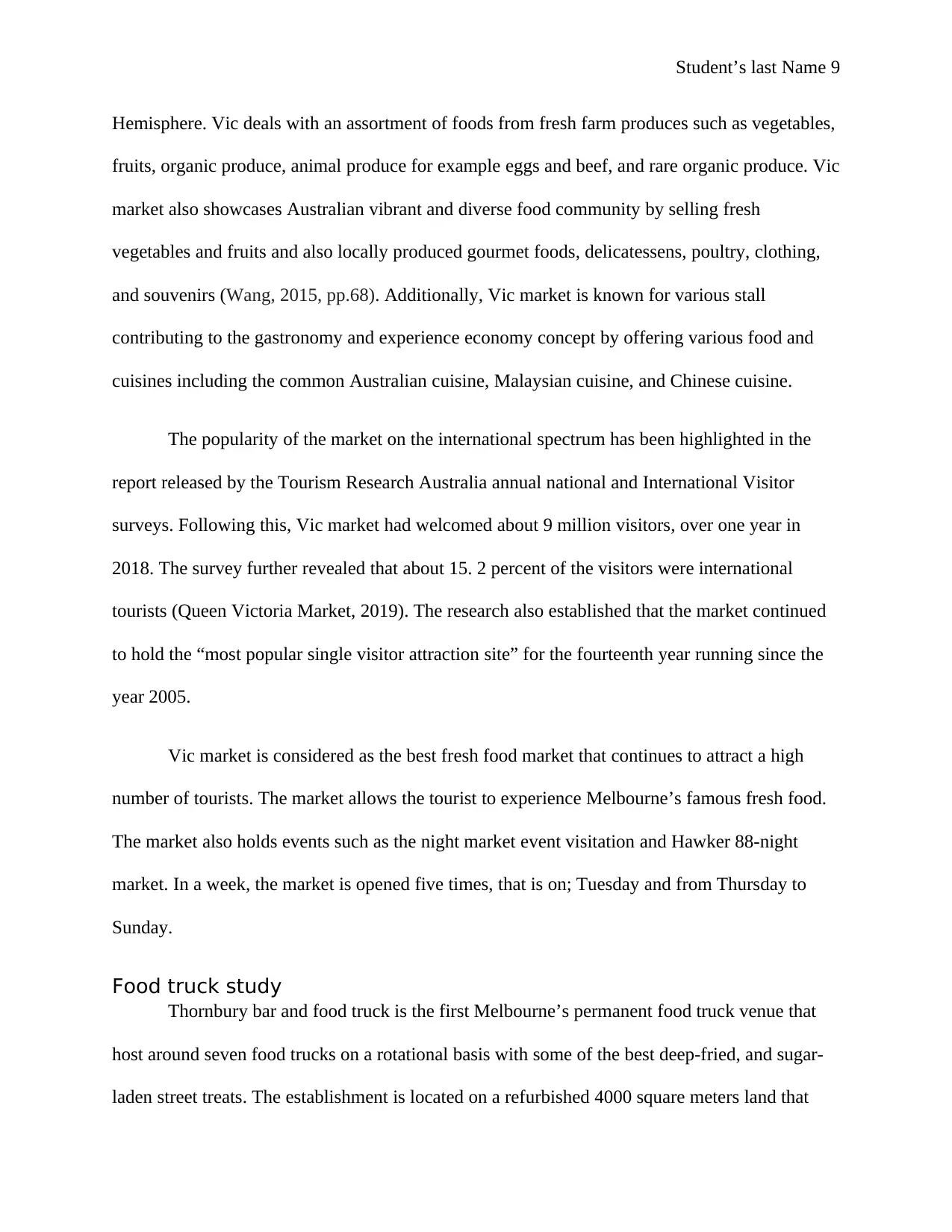
Student’s last Name 9
Hemisphere. Vic deals with an assortment of foods from fresh farm produces such as vegetables,
fruits, organic produce, animal produce for example eggs and beef, and rare organic produce. Vic
market also showcases Australian vibrant and diverse food community by selling fresh
vegetables and fruits and also locally produced gourmet foods, delicatessens, poultry, clothing,
and souvenirs (Wang, 2015, pp.68). Additionally, Vic market is known for various stall
contributing to the gastronomy and experience economy concept by offering various food and
cuisines including the common Australian cuisine, Malaysian cuisine, and Chinese cuisine.
The popularity of the market on the international spectrum has been highlighted in the
report released by the Tourism Research Australia annual national and International Visitor
surveys. Following this, Vic market had welcomed about 9 million visitors, over one year in
2018. The survey further revealed that about 15. 2 percent of the visitors were international
tourists (Queen Victoria Market, 2019). The research also established that the market continued
to hold the “most popular single visitor attraction site” for the fourteenth year running since the
year 2005.
Vic market is considered as the best fresh food market that continues to attract a high
number of tourists. The market allows the tourist to experience Melbourne’s famous fresh food.
The market also holds events such as the night market event visitation and Hawker 88-night
market. In a week, the market is opened five times, that is on; Tuesday and from Thursday to
Sunday.
Food truck study
Thornbury bar and food truck is the first Melbourne’s permanent food truck venue that
host around seven food trucks on a rotational basis with some of the best deep-fried, and sugar-
laden street treats. The establishment is located on a refurbished 4000 square meters land that
Hemisphere. Vic deals with an assortment of foods from fresh farm produces such as vegetables,
fruits, organic produce, animal produce for example eggs and beef, and rare organic produce. Vic
market also showcases Australian vibrant and diverse food community by selling fresh
vegetables and fruits and also locally produced gourmet foods, delicatessens, poultry, clothing,
and souvenirs (Wang, 2015, pp.68). Additionally, Vic market is known for various stall
contributing to the gastronomy and experience economy concept by offering various food and
cuisines including the common Australian cuisine, Malaysian cuisine, and Chinese cuisine.
The popularity of the market on the international spectrum has been highlighted in the
report released by the Tourism Research Australia annual national and International Visitor
surveys. Following this, Vic market had welcomed about 9 million visitors, over one year in
2018. The survey further revealed that about 15. 2 percent of the visitors were international
tourists (Queen Victoria Market, 2019). The research also established that the market continued
to hold the “most popular single visitor attraction site” for the fourteenth year running since the
year 2005.
Vic market is considered as the best fresh food market that continues to attract a high
number of tourists. The market allows the tourist to experience Melbourne’s famous fresh food.
The market also holds events such as the night market event visitation and Hawker 88-night
market. In a week, the market is opened five times, that is on; Tuesday and from Thursday to
Sunday.
Food truck study
Thornbury bar and food truck is the first Melbourne’s permanent food truck venue that
host around seven food trucks on a rotational basis with some of the best deep-fried, and sugar-
laden street treats. The establishment is located on a refurbished 4000 square meters land that
⊘ This is a preview!⊘
Do you want full access?
Subscribe today to unlock all pages.

Trusted by 1+ million students worldwide
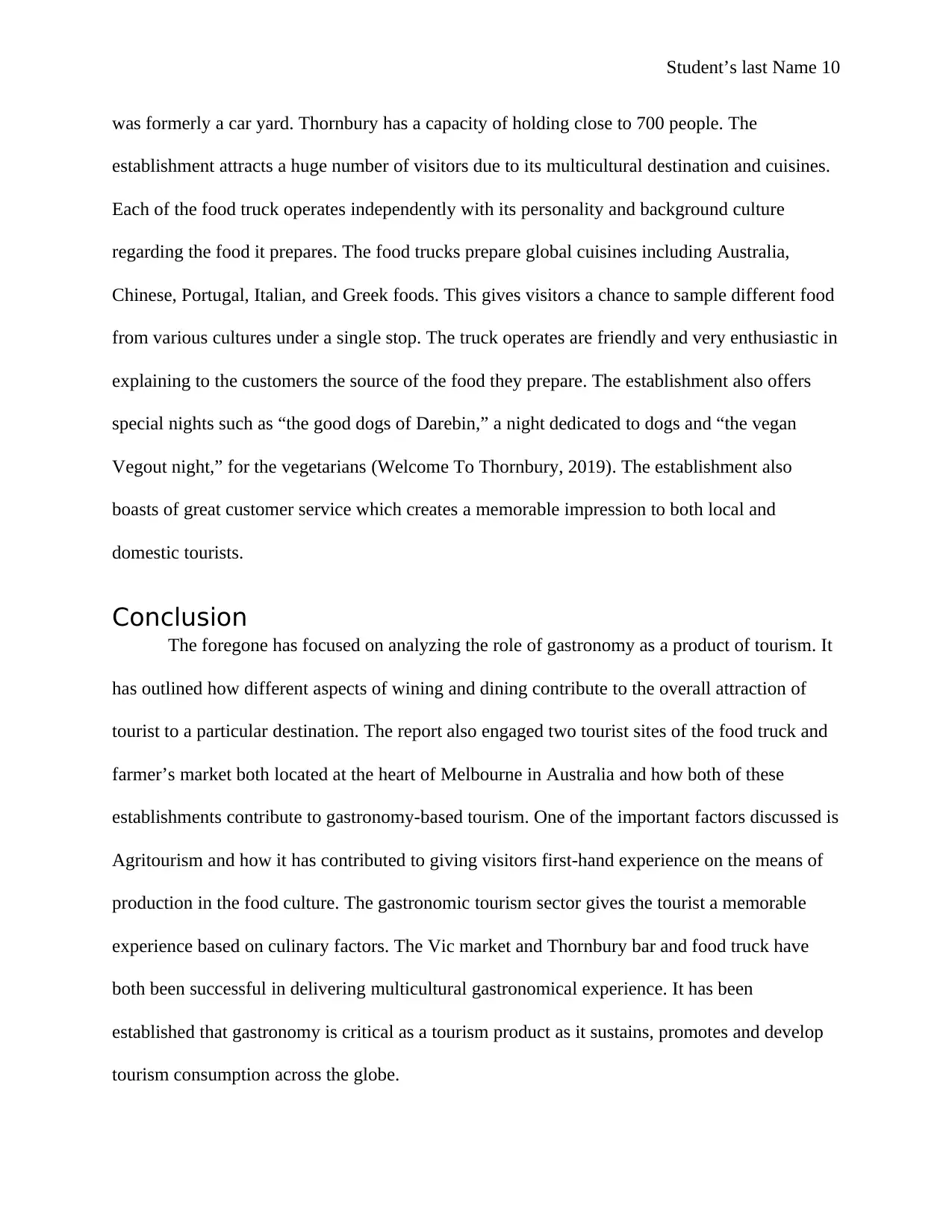
Student’s last Name 10
was formerly a car yard. Thornbury has a capacity of holding close to 700 people. The
establishment attracts a huge number of visitors due to its multicultural destination and cuisines.
Each of the food truck operates independently with its personality and background culture
regarding the food it prepares. The food trucks prepare global cuisines including Australia,
Chinese, Portugal, Italian, and Greek foods. This gives visitors a chance to sample different food
from various cultures under a single stop. The truck operates are friendly and very enthusiastic in
explaining to the customers the source of the food they prepare. The establishment also offers
special nights such as “the good dogs of Darebin,” a night dedicated to dogs and “the vegan
Vegout night,” for the vegetarians (Welcome To Thornbury, 2019). The establishment also
boasts of great customer service which creates a memorable impression to both local and
domestic tourists.
Conclusion
The foregone has focused on analyzing the role of gastronomy as a product of tourism. It
has outlined how different aspects of wining and dining contribute to the overall attraction of
tourist to a particular destination. The report also engaged two tourist sites of the food truck and
farmer’s market both located at the heart of Melbourne in Australia and how both of these
establishments contribute to gastronomy-based tourism. One of the important factors discussed is
Agritourism and how it has contributed to giving visitors first-hand experience on the means of
production in the food culture. The gastronomic tourism sector gives the tourist a memorable
experience based on culinary factors. The Vic market and Thornbury bar and food truck have
both been successful in delivering multicultural gastronomical experience. It has been
established that gastronomy is critical as a tourism product as it sustains, promotes and develop
tourism consumption across the globe.
was formerly a car yard. Thornbury has a capacity of holding close to 700 people. The
establishment attracts a huge number of visitors due to its multicultural destination and cuisines.
Each of the food truck operates independently with its personality and background culture
regarding the food it prepares. The food trucks prepare global cuisines including Australia,
Chinese, Portugal, Italian, and Greek foods. This gives visitors a chance to sample different food
from various cultures under a single stop. The truck operates are friendly and very enthusiastic in
explaining to the customers the source of the food they prepare. The establishment also offers
special nights such as “the good dogs of Darebin,” a night dedicated to dogs and “the vegan
Vegout night,” for the vegetarians (Welcome To Thornbury, 2019). The establishment also
boasts of great customer service which creates a memorable impression to both local and
domestic tourists.
Conclusion
The foregone has focused on analyzing the role of gastronomy as a product of tourism. It
has outlined how different aspects of wining and dining contribute to the overall attraction of
tourist to a particular destination. The report also engaged two tourist sites of the food truck and
farmer’s market both located at the heart of Melbourne in Australia and how both of these
establishments contribute to gastronomy-based tourism. One of the important factors discussed is
Agritourism and how it has contributed to giving visitors first-hand experience on the means of
production in the food culture. The gastronomic tourism sector gives the tourist a memorable
experience based on culinary factors. The Vic market and Thornbury bar and food truck have
both been successful in delivering multicultural gastronomical experience. It has been
established that gastronomy is critical as a tourism product as it sustains, promotes and develop
tourism consumption across the globe.
Paraphrase This Document
Need a fresh take? Get an instant paraphrase of this document with our AI Paraphraser
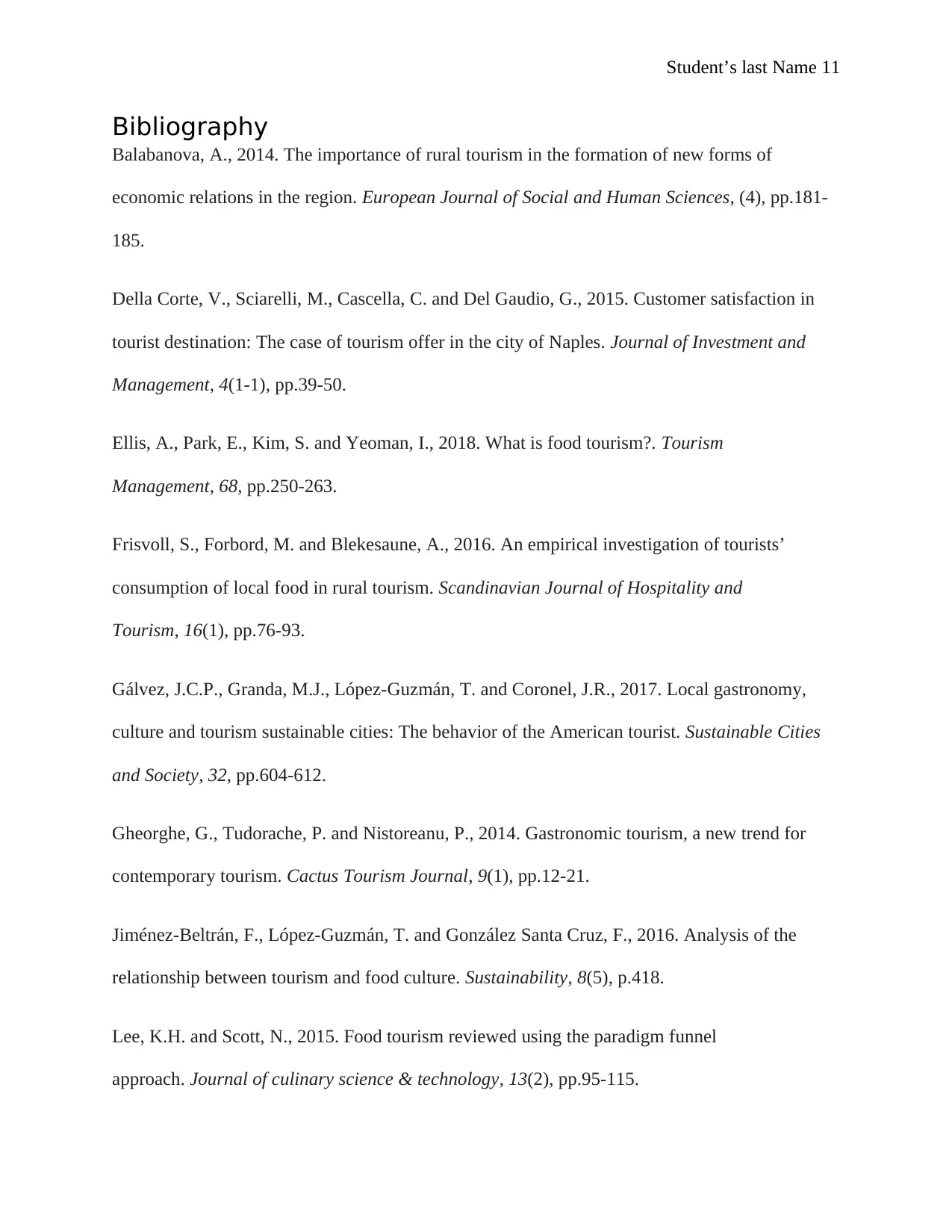
Student’s last Name 11
Bibliography
Balabanova, A., 2014. The importance of rural tourism in the formation of new forms of
economic relations in the region. European Journal of Social and Human Sciences, (4), pp.181-
185.
Della Corte, V., Sciarelli, M., Cascella, C. and Del Gaudio, G., 2015. Customer satisfaction in
tourist destination: The case of tourism offer in the city of Naples. Journal of Investment and
Management, 4(1-1), pp.39-50.
Ellis, A., Park, E., Kim, S. and Yeoman, I., 2018. What is food tourism?. Tourism
Management, 68, pp.250-263.
Frisvoll, S., Forbord, M. and Blekesaune, A., 2016. An empirical investigation of tourists’
consumption of local food in rural tourism. Scandinavian Journal of Hospitality and
Tourism, 16(1), pp.76-93.
Gálvez, J.C.P., Granda, M.J., López-Guzmán, T. and Coronel, J.R., 2017. Local gastronomy,
culture and tourism sustainable cities: The behavior of the American tourist. Sustainable Cities
and Society, 32, pp.604-612.
Gheorghe, G., Tudorache, P. and Nistoreanu, P., 2014. Gastronomic tourism, a new trend for
contemporary tourism. Cactus Tourism Journal, 9(1), pp.12-21.
Jiménez-Beltrán, F., López-Guzmán, T. and González Santa Cruz, F., 2016. Analysis of the
relationship between tourism and food culture. Sustainability, 8(5), p.418.
Lee, K.H. and Scott, N., 2015. Food tourism reviewed using the paradigm funnel
approach. Journal of culinary science & technology, 13(2), pp.95-115.
Bibliography
Balabanova, A., 2014. The importance of rural tourism in the formation of new forms of
economic relations in the region. European Journal of Social and Human Sciences, (4), pp.181-
185.
Della Corte, V., Sciarelli, M., Cascella, C. and Del Gaudio, G., 2015. Customer satisfaction in
tourist destination: The case of tourism offer in the city of Naples. Journal of Investment and
Management, 4(1-1), pp.39-50.
Ellis, A., Park, E., Kim, S. and Yeoman, I., 2018. What is food tourism?. Tourism
Management, 68, pp.250-263.
Frisvoll, S., Forbord, M. and Blekesaune, A., 2016. An empirical investigation of tourists’
consumption of local food in rural tourism. Scandinavian Journal of Hospitality and
Tourism, 16(1), pp.76-93.
Gálvez, J.C.P., Granda, M.J., López-Guzmán, T. and Coronel, J.R., 2017. Local gastronomy,
culture and tourism sustainable cities: The behavior of the American tourist. Sustainable Cities
and Society, 32, pp.604-612.
Gheorghe, G., Tudorache, P. and Nistoreanu, P., 2014. Gastronomic tourism, a new trend for
contemporary tourism. Cactus Tourism Journal, 9(1), pp.12-21.
Jiménez-Beltrán, F., López-Guzmán, T. and González Santa Cruz, F., 2016. Analysis of the
relationship between tourism and food culture. Sustainability, 8(5), p.418.
Lee, K.H. and Scott, N., 2015. Food tourism reviewed using the paradigm funnel
approach. Journal of culinary science & technology, 13(2), pp.95-115.
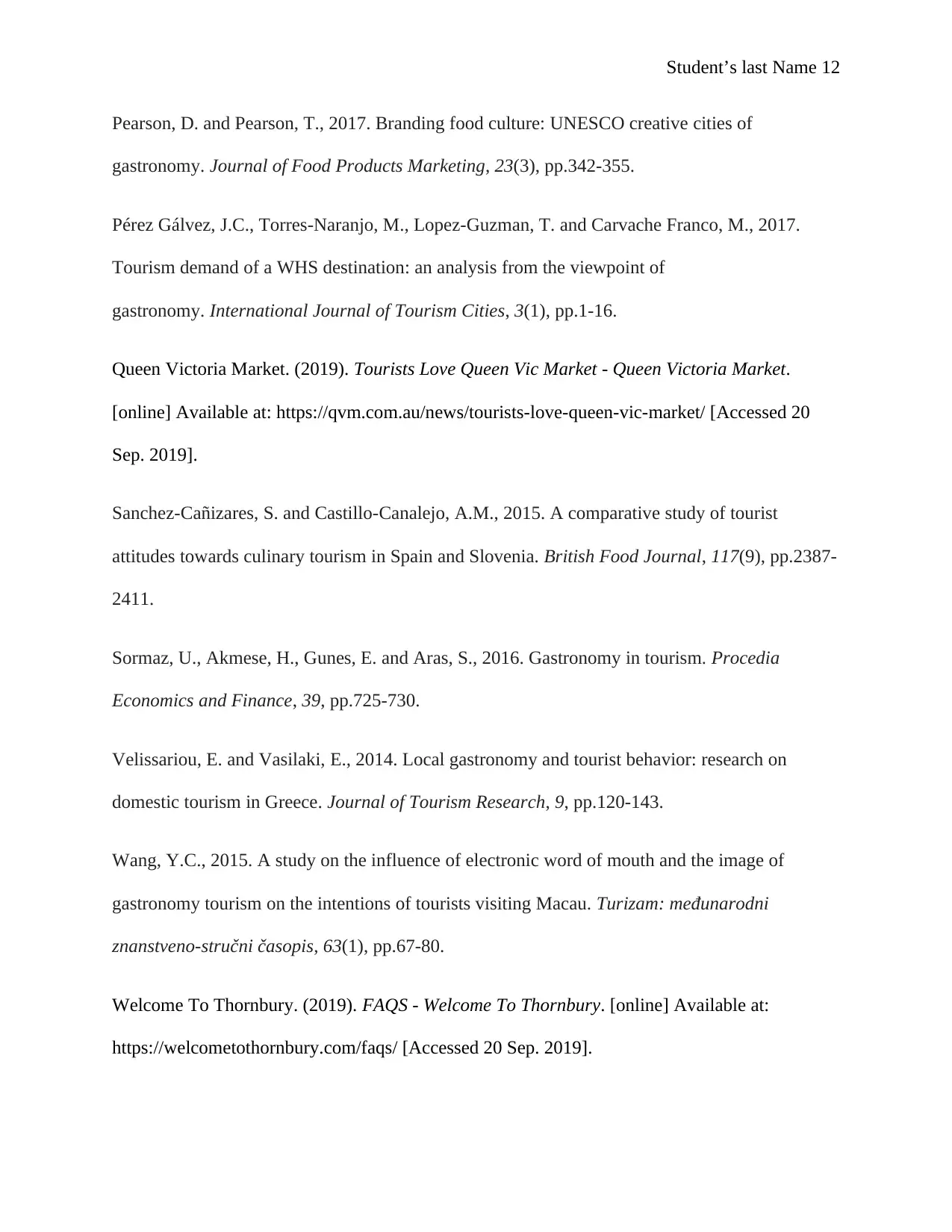
Student’s last Name 12
Pearson, D. and Pearson, T., 2017. Branding food culture: UNESCO creative cities of
gastronomy. Journal of Food Products Marketing, 23(3), pp.342-355.
Pérez Gálvez, J.C., Torres-Naranjo, M., Lopez-Guzman, T. and Carvache Franco, M., 2017.
Tourism demand of a WHS destination: an analysis from the viewpoint of
gastronomy. International Journal of Tourism Cities, 3(1), pp.1-16.
Queen Victoria Market. (2019). Tourists Love Queen Vic Market - Queen Victoria Market.
[online] Available at: https://qvm.com.au/news/tourists-love-queen-vic-market/ [Accessed 20
Sep. 2019].
Sanchez-Cañizares, S. and Castillo-Canalejo, A.M., 2015. A comparative study of tourist
attitudes towards culinary tourism in Spain and Slovenia. British Food Journal, 117(9), pp.2387-
2411.
Sormaz, U., Akmese, H., Gunes, E. and Aras, S., 2016. Gastronomy in tourism. Procedia
Economics and Finance, 39, pp.725-730.
Velissariou, E. and Vasilaki, E., 2014. Local gastronomy and tourist behavior: research on
domestic tourism in Greece. Journal of Tourism Research, 9, pp.120-143.
Wang, Y.C., 2015. A study on the influence of electronic word of mouth and the image of
gastronomy tourism on the intentions of tourists visiting Macau. Turizam: međunarodni
znanstveno-stručni časopis, 63(1), pp.67-80.
Welcome To Thornbury. (2019). FAQS - Welcome To Thornbury. [online] Available at:
https://welcometothornbury.com/faqs/ [Accessed 20 Sep. 2019].
Pearson, D. and Pearson, T., 2017. Branding food culture: UNESCO creative cities of
gastronomy. Journal of Food Products Marketing, 23(3), pp.342-355.
Pérez Gálvez, J.C., Torres-Naranjo, M., Lopez-Guzman, T. and Carvache Franco, M., 2017.
Tourism demand of a WHS destination: an analysis from the viewpoint of
gastronomy. International Journal of Tourism Cities, 3(1), pp.1-16.
Queen Victoria Market. (2019). Tourists Love Queen Vic Market - Queen Victoria Market.
[online] Available at: https://qvm.com.au/news/tourists-love-queen-vic-market/ [Accessed 20
Sep. 2019].
Sanchez-Cañizares, S. and Castillo-Canalejo, A.M., 2015. A comparative study of tourist
attitudes towards culinary tourism in Spain and Slovenia. British Food Journal, 117(9), pp.2387-
2411.
Sormaz, U., Akmese, H., Gunes, E. and Aras, S., 2016. Gastronomy in tourism. Procedia
Economics and Finance, 39, pp.725-730.
Velissariou, E. and Vasilaki, E., 2014. Local gastronomy and tourist behavior: research on
domestic tourism in Greece. Journal of Tourism Research, 9, pp.120-143.
Wang, Y.C., 2015. A study on the influence of electronic word of mouth and the image of
gastronomy tourism on the intentions of tourists visiting Macau. Turizam: međunarodni
znanstveno-stručni časopis, 63(1), pp.67-80.
Welcome To Thornbury. (2019). FAQS - Welcome To Thornbury. [online] Available at:
https://welcometothornbury.com/faqs/ [Accessed 20 Sep. 2019].
⊘ This is a preview!⊘
Do you want full access?
Subscribe today to unlock all pages.

Trusted by 1+ million students worldwide
1 out of 13
Related Documents
Your All-in-One AI-Powered Toolkit for Academic Success.
+13062052269
info@desklib.com
Available 24*7 on WhatsApp / Email
![[object Object]](/_next/static/media/star-bottom.7253800d.svg)
Unlock your academic potential
Copyright © 2020–2025 A2Z Services. All Rights Reserved. Developed and managed by ZUCOL.





